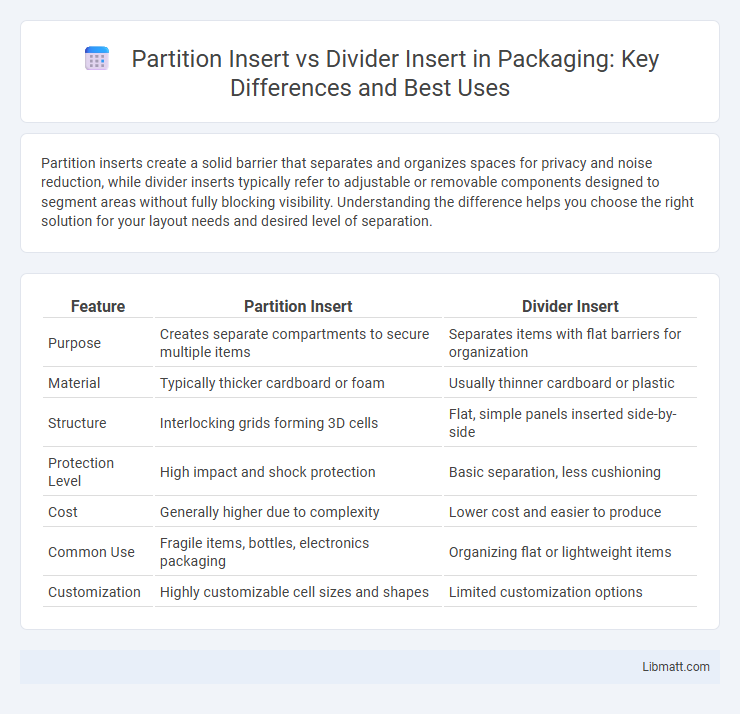Partition inserts create a solid barrier that separates and organizes spaces for privacy and noise reduction, while divider inserts typically refer to adjustable or removable components designed to segment areas without fully blocking visibility. Understanding the difference helps you choose the right solution for your layout needs and desired level of separation.
Table of Comparison
| Feature | Partition Insert | Divider Insert |
|---|---|---|
| Purpose | Creates separate compartments to secure multiple items | Separates items with flat barriers for organization |
| Material | Typically thicker cardboard or foam | Usually thinner cardboard or plastic |
| Structure | Interlocking grids forming 3D cells | Flat, simple panels inserted side-by-side |
| Protection Level | High impact and shock protection | Basic separation, less cushioning |
| Cost | Generally higher due to complexity | Lower cost and easier to produce |
| Common Use | Fragile items, bottles, electronics packaging | Organizing flat or lightweight items |
| Customization | Highly customizable cell sizes and shapes | Limited customization options |
Understanding Partition Inserts and Divider Inserts
Partition inserts are used to create separated sections within a container, optimizing organization and storage efficiency by maximizing the use of internal space. Divider inserts function as removable or adjustable barriers that enable customization of compartment sizes for versatile arrangement and easy access. Both inserts enhance product protection and presentation, tailored to specific packaging needs across various industries.
Key Differences Between Partition Inserts and Divider Inserts
Partition inserts and divider inserts serve distinct purposes in organizing spaces or objects. Partition inserts primarily create separate sections within a larger area, providing structural separation and privacy, while divider inserts are designed to separate items within a single compartment, enhancing organization and accessibility. Understanding these key differences helps you choose the right insert type to optimize space management and functionality effectively.
Common Materials Used in Partition and Divider Inserts
Partition and divider inserts are commonly made from materials such as acrylic, polycarbonate, wood, and metal, each offering varying levels of durability, transparency, and aesthetic appeal. Acrylic and polycarbonate are favored for their lightweight properties and clarity, ideal for maintaining visibility while providing protection. Wood and metal inserts offer sturdier, more opaque barriers, enhancing privacy and structural integrity for your space.
Applications of Partition Inserts in Storage Solutions
Partition inserts in storage solutions optimize organization by creating customizable compartments suitable for tools, electronic components, or office supplies. These inserts enhance space utilization by securely holding items and preventing movement during transport, making them essential for modular toolboxes, camera bags, and industrial storage cases. Unlike divider inserts that generally rely on fixed segments, partition inserts offer flexible configuration options, tailored to specific storage needs and product dimensions.
Divider Inserts: Ideal Uses and Benefits
Divider inserts provide precise alignment and secure separation in partition systems, enhancing overall structural stability. Their design enables easy installation and removal, making them ideal for modular office layouts, retail displays, and room dividers where flexibility is essential. You benefit from improved organization and aesthetic appeal, as divider inserts maintain consistent spacing and clean lines across various applications.
Installation Techniques for Partition and Divider Inserts
Partition inserts require precise alignment within designated slots or grooves to ensure a secure fit during installation, often employing adhesive backing or snap-in mechanisms for stability. Divider inserts typically involve simpler installation methods, such as sliding into pre-cut channels or clipping onto edges, allowing for easy repositioning and removal. Your choice between partition and divider inserts should consider the installation environment and desired permanence, as partition inserts demand more meticulous setup compared to the flexible nature of divider inserts.
Customization Options: Partition vs Divider Inserts
Partition inserts offer extensive customization options including adjustable sizes, materials, and configurations to fit specific storage or organization needs. Divider inserts typically provide fewer customization choices but are designed for simple segmentation, often fixed in size or material. Your selection should depend on whether you prioritize tailored organization solutions or straightforward item separation.
Durability and Maintenance: Comparative Analysis
Partition inserts offer superior durability due to their robust construction designed for high wear resistance, ensuring long-term structural integrity in heavy-use applications. Divider inserts provide easier maintenance with modular components that allow quick replacement and customization, reducing downtime during repairs or adjustments. Your choice depends on prioritizing either sustained durability or simplified maintenance efficiency in your operational environment.
Cost Considerations: Partition Insert vs Divider Insert
Partition inserts generally offer lower long-term costs due to improved material utilization and reduced tooling changes, making them ideal for high-volume production runs. Divider inserts tend to incur higher initial expenses driven by complex setup and maintenance requirements, impacting smaller batch operations more significantly. Evaluating cost efficiency involves balancing production volume against tooling lifespan and maintenance frequency for each insert type.
Choosing the Right Insert for Your Organizational Needs
Partition inserts maximize workspace efficiency by compartmentalizing areas for specific tasks or items, ideal for detailed organization in drawers or desks. Divider inserts provide adjustable sections to customize storage space, offering flexibility to accommodate varying sizes of tools or supplies. Selecting the right insert depends on your need for fixed precision organization versus adaptable storage solutions suited to diverse office environments.
Partition insert vs divider insert Infographic

 libmatt.com
libmatt.com